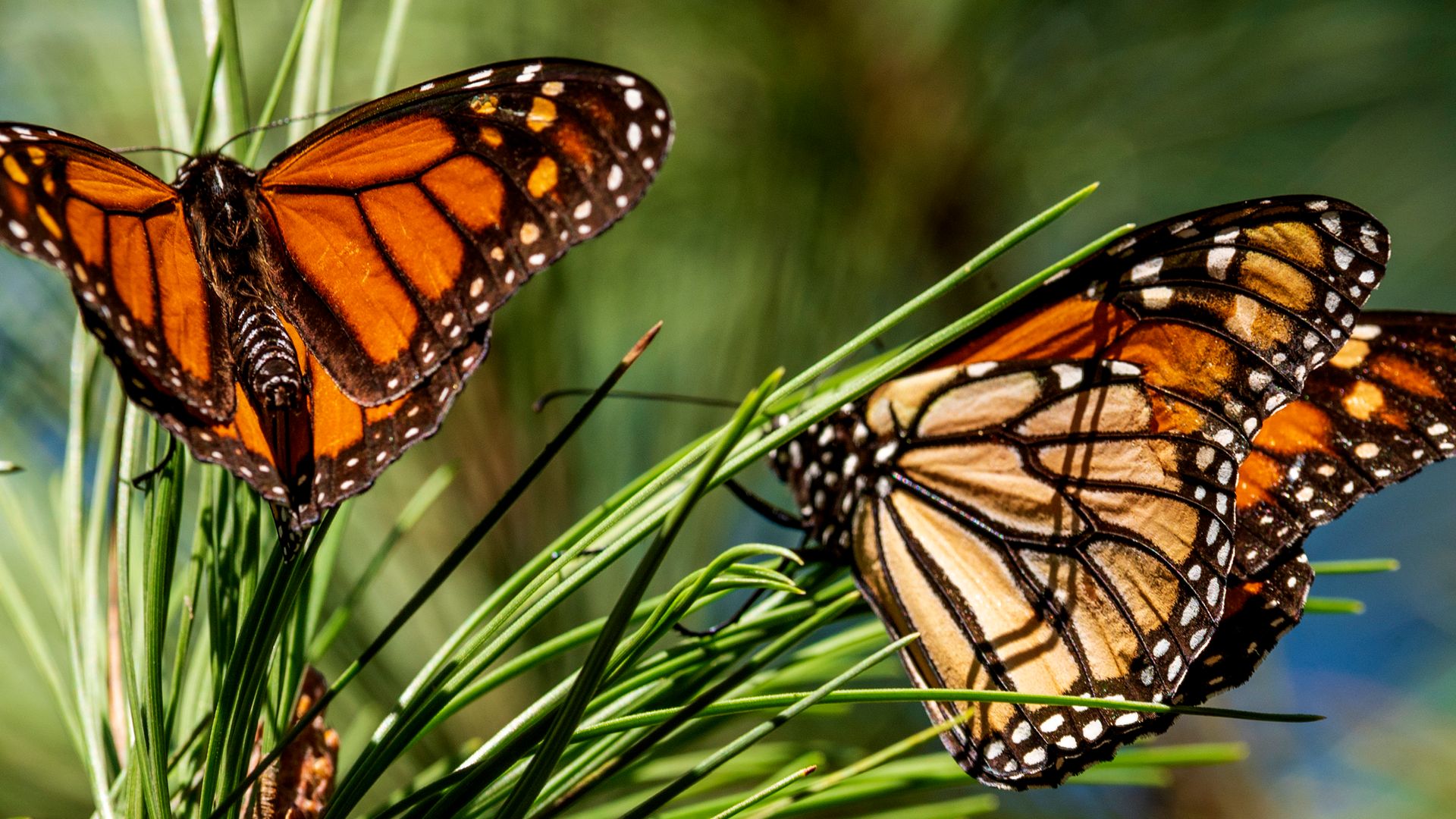
US monarch butterfly population nears 30-year low
By Jack Aylmer (Anchor), Shea Taylor (Producer), Emma Stoltzfus (Producer/Video Editor), Ali Caldwell (Motion Graphic Designer)
- The monarch butterfly population in the western U.S. hit a nearly 30-year low in 2024. That’s a 96% drop compared to the population in 2023.
- Experts blamed a combination of vanishing habitats, climate change and pesticides.
- Due to declining populations of pollinators, monarchs are expected to become a protected species in the U.S. in 2025.
Fewer monarch butterflies have spent winter in the western U.S. as factors like pesticides, a disappearing habitat, and climate change have affected the population. The population is now at a 30-year low.
Media Landscape
See how news outlets across the political spectrum are covering this story. Learn moreBias Distribution
Left
Right
Untracked Bias
What is known about monarch butterflies in western America?
Since 1997, the Xerces Society for Invertebrate Conservation has been monitoring the overwintering monarch butterfly population west of the Rocky Mountains.

Download the SAN app today to stay up-to-date with Unbiased. Straight Facts™.
Point phone camera here
During the winter, the butterflies migrate to the California coast — northern Baja and inland California — and Arizona.
The society said it recorded its lowest number of monarch butterflies ever in 2024.
When the Xerces Society started tracking the species in 1997, it counted 1.2 million winged insects, the highest number ever recorded in the area.
In 2024, it saw a 96% drop in the population compared to the year before, counting just 9,119 monarch butterflies.
It’s the second-lowest number they’ve ever counted in 28 years of tracking data. The lowest was 1,901 monarch butterflies in 2020.
What’s causing the population decline?
Monarchs across North America have faced mounting threats. The biggest threat is the vanishing milkweed, which is the host plant for caterpillars that metamorphosize into butterflies.
Experts said a combination of drought, wildfires, agriculture and urban development have caused the plants to disappear. Plus, pesticides have contaminated many of those that remain.
However, the Xerces Society said it’s unclear what caused such a massive drop in the Western monarch butterfly population between 2023 and 2024.
Still, it serves as another example of a bigger trend.
In December 2024, the U.S. Fish and Wildlife Service announced it plans to add monarch butterflies to its threatened species list by the end of 2025, making it illegal to kill them purposely or transport them.
Get up to speed on the stories leading the day every weekday morning. Sign up for the newsletter today!
Learn more about our emails. Unsubscribe anytime.
By entering your email, you agree to the Terms & Conditions and acknowledge the Privacy Policy.
What about butterflies in the eastern US?
It’s currently unknown if the eastern U.S. monarch population saw the same drop in 2024.
Monarchs travel to Mexico for the winter and are monitored by the World Wildlife Fund, which has not yet released its 2024 data.
How can Americans help?
There are several ways to help revive the dwindling population of these much-needed pollinators.
The Xerces Society’s website is full of ways Americans can help, from planting certain seeds in their gardens to managing habitats specifically for monarch butterflies.
[JACK AYLMER]
FEWER MONARCH BUTTERFLIES ARE SPENDING THEIR WINTER IN THE WESTERN UNITED STATES AS FACTORS LIKE PESTICIDES, A DISAPPEARING HABITAT AND CLIMATE CHANGE TAKE THEIR TOLL, ACCORDING TO THE NONPROFIT MONITORING THE POLLINATORS.
THE XERCES SOCIETY FOR INVERTEBRATE CONSERVATION HAS BEEN MONITORING THE OVERWINTER MONARCH BUTTERFLY POPULATION WEST OF THE ROCKY MOUNTAINS SINCE 19-97.
DURING THE WINTER, THE BUTTERFLIES MIGRATE TO THE CALIFORNIA COAST, NORTHERN BAJA CALIFORNIA, AND INLAND CALIFORNIA AND ARIZONA.
THE SOCIETY SAYS IN 20-24 – THEY RECORDED THEIR LOWEST NUMBER OF MONARCH BUTTERFLIES EVER.
WHEN THEY STARTED KEEPING TRACK IN 19-97 – THEY COUNTED 1 POINT 2 MILLION OF THE BEAUTIFUL INSECTS, THE HIGHEST NUMBER EVER RECORDED IN THE AREA.
BUT IN 20-24 – THEY SAW A 96 PERCENT DROP IN THE POPULATION COMPARED TO THE YEAR BEFORE…
COUNTING JUST OVER 91-HUNDRED MONARCH BUTTERFLIES.
IT’S THE SECOND-LOWEST NUMBER THEY’VE EVER COUNTED IN 28 YEARS OF TRACKING DATA…
THE LOWEST WAS JUST BARELY 19-HUNDRED IN 20-20.
MONARCHS ACROSS NORTH AMERICA HAVE FACED MOUNTING THREATS IN RECENT YEARS – THE BIGGEST BEING VANISHING MILKWEED.
MILKWEED IS THE HOST PLANT FOR CATERPILLARS THAT METAMORPHASIZE INTO THE BUTTERFLIES.
EXPERTS SAY A COMBINATION OF DROUGHT, WILDFIRES, AGRICULTURE AND URBAN DEVELOPMENT HAVE CAUSED THE PLANT TO DISAPPEAR… AND PESTICIDES HAVE CONTAMINATED MANY OF THOSE THAT REMAIN.
THOUGH, THE XERCES SOCIETY SAYS IT’S NOT CLEAR **WHAT EXACTLY** CAUSED SUCH A MASSIVE DROP IN THE WESTERN POPULATION IN JUST ONE YEAR.
STILL, IT’S ANOTHER EXAMPLE OF A BIGGER TREND.
JUST IN DECEMBER – THE U-S FISH AND WILDLIFE SERVICE ANNOUNCED IT PLANS TO ADD MONARCH BUTTERFLIES TO ITS THREATENED SPECIES LIST BY THE END OF 20-25… MAKING IT ILLEGAL TO PURPOSELY KILL THE BUTTERFLIES OR TRANSPORT THEM.
WE DON’T KNOW YET IF THE EASTERN U-S’ POPULATION OF MONARCHS SAW THE SAME POPULATION DROP IN 20-24.
THEY TRAVEL TO MEXICO FOR THE WINTER AND ARE MONITORED BY THE WORLD WILDLIFE FUND – WHICH HAS NOT YET RELEASED ITS 20-24 DATA.
WE’LL KEEP YOU UPDATED ON THIS AND OTHER STORIES THAT IMPACT OUR WORLD – TO MAKE SURE YOU GET THE LATEST DELIVERED RIGHT TO THE PALM FOR YOUR HAND, DOWNLOAD THE STRAIGHT ARROW NEWS APP TODAY.
Media Landscape
See how news outlets across the political spectrum are covering this story. Learn moreBias Distribution
Left
Right
Untracked Bias
Straight to your inbox.
By entering your email, you agree to the Terms & Conditions and acknowledge the Privacy Policy.
MOST POPULAR
-
 Getty Images
Getty Images
Billions of cicadas emerge in 13 states this spring
Read11 hrs ago -
 Getty Images
Getty Images
Mark Carney to succeed Justin Trudeau as head of Canada’s Liberal Party
Read12 hrs ago -
 Getty Images
Getty Images
DHS sees leadership shakeup amid ICE operation leaks
Read12 hrs ago -
 Reuters
Reuters
Pope Francis health update: gradual improvement
ReadSaturday




